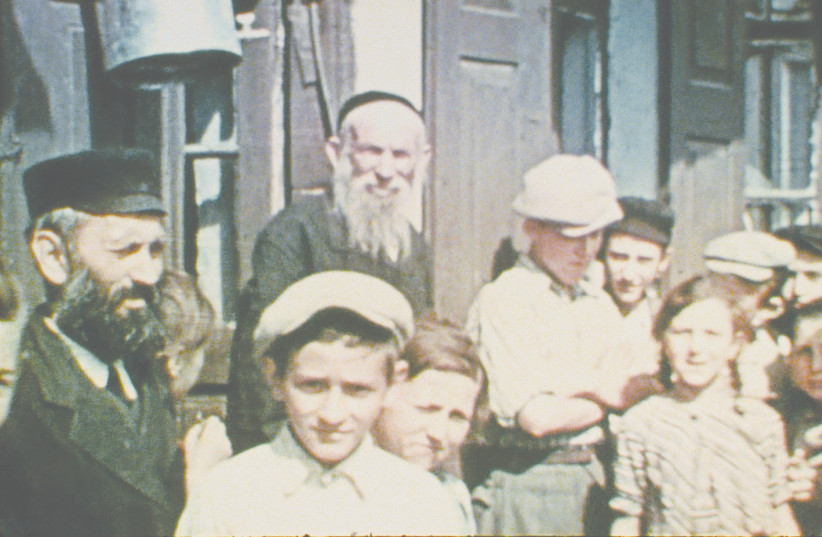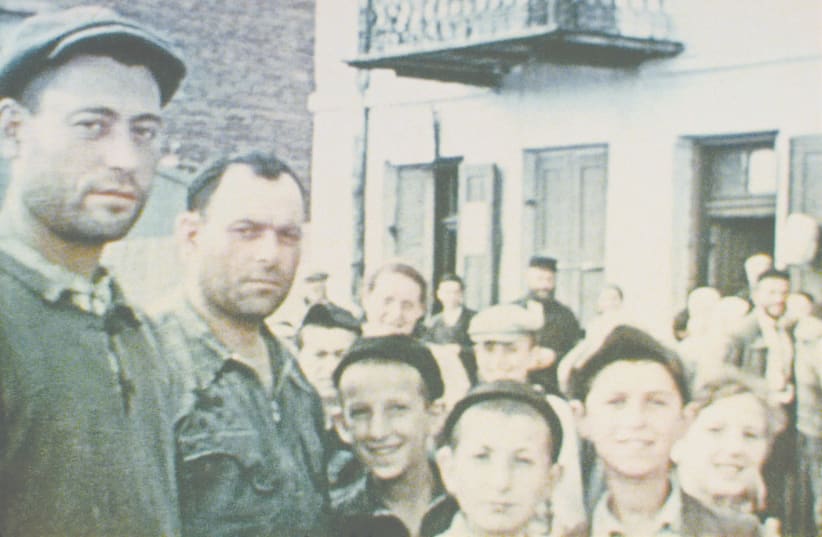How about this for a philosophical dome scratcher? How do you turn three minutes into 68? Bianca Stigter managed that, without the benefit of Star Trek time warp technology or the scientific – or chemical – means of creating an alternative reality. She simply developed, coaxed, crafted and lovingly nurtured over an hour of riveting and evocative viewing from a brief glimpse of life from a world now gone forever.
We are not just talking about any old historical vignette. Stigter’s Three Minutes: A Lengthening, which screens at Docaviv – the Tel Aviv International Documentary Film Festival on Tuesday and Thursday, offers a unique view of the life of the Jewish community in the small Polish town of Nasielsk, just north of Warsaw, captured in August 1938.
What we see is a motley group of Jews, of clearly different observance leanings and, probably, socioeconomic strata, hamming it up for the camera, or eyeing the lens with undisguised suspicion. It is evident that the vast majority of the folks in the film, if not all of them, had probably never seen a movie camera before.
The Three Minutes venture is a multilayered affair. First off, Stigter is a Dutch historian who had previously never tried her hand at filmmaking. It is quite a directorial debut, and one that has landed her an award from Yad Vashem, as well as screenings across the globe. It is thoroughly deserved.
“I wasn’t planning on making a movie, it just happened,” Stigter laughs. “There are so many coincidences in this story. It is really amazing it happened at all.”
“There are so many coincidences in this story. It is really amazing it happened at all.”
Bianca Stigter

Indeed, but, as a sage Indian musician told me quite a few years ago now, it is always happening now.
How it happened
Stigter came across the base raw material for the project by virtual means.
“I found it on Facebook,” she recalls. “There was this post called Three Minutes in Poland. I thought that was an intriguing title. It was a book written by someone called Glenn Kurtz about a film his grandfather had made in 1938.”
She was duly intrigued and was keen to dig into the matter. Luckily, the source material was readily accessible. “It said you could see that footage on the website of the Holocaust Memorial Museum [in Washington, DC].”
This wasn’t just one of these entertaining fleeting flurries of color or action, or melodramatic scenes you get in abundance, say, on YouTube.
“I was touched, fascinated, [by] all kinds of conflicting emotion from seeing this footage,” Stigter says, noting that the short film conveyed unusual immediacy. “It was in color. It is quite rare to see authentic material from that time in color.”
Therein lies much of the film’s charm and its ability to draw the viewer in. The all-too-brief clip clearly conveys life as it really was back then, in color and with movement. This is not some assortment of black-and-white prints which survived the horrific and traumatic events of the Holocaust, and serve to remind us of a world frozen in time that was to be decimated and crushed under Nazi boots. In Three Minutes we see actual people, with facial expressions, whimsical, taciturn, shy and insouciant. These are people who were just getting on with their lives in a place where Jews had lived, worked, married, had kids and died for over four centuries. What could possibly happen to make things any different?
But it is impossible to watch the film and shunt aside the knowledge that, just one year later, that parochial, happily mundane existence was to be cruelly and irrevocably truncated.
The filming
The footage was shot by David Kurtz. He was born in Nasielsk but left as a child, with his parents, for the US. He eventually made good and, in summer 1938, decided to do “the grand tour of Europe,” together with his wife and another couple.
Even so, had the Kurtz foursome stuck to their original plan, Three Minutes would probably never have come to be. Their scheduled vacation itinerary took them through all the customary culture centers – London, Paris, Amsterdam etc. But, at some point, they decided to improvise and took a detour to Kurtz’s birthplace.
We are told that he had only acquired the movie camera a couple of months earlier, probably in anticipation of the trip and because of a desire to document excursion highlights. That comes through in the less than professional frame composition and continuity of the footage and, once again, that only serves to make the end product all the more endearing and precious.
After shooting the amateurish reel of film and, presumably, watching and showing it a few times, Kurtz consigned it to a drawer in his home, and it was eventually forgotten. Glenn Kurtz discovered the reel only in 2009, and, it seems, not a moment too soon. The experts at the Holocaust Memorial Museum, to whom Kurtz Jr. entrusted the invaluable find, said that had he come across the material another month or so later, it would probably have been irretrievable.
Happily, the fates conspired on all sorts of levels, so that Three Minutes, the book and the movie camera clip, could come to be.
“It is amazing,” says Stigter. “It shows us how fragile everything is and what we can remember.”
THAT IS an important point. What, indeed, can we remember? What can the human mind even contemplate? The oft-cited six million figure is pressed into service so frequently, but, as anti-Nazi German journalist and satirist Kurt Tucholsky once mused in a satirical essay he wrote in 1932: “The death of one man: this is a catastrophe. Hundreds of thousands of deaths: that is a statistic!”
But, the mind-boggling fact is that the millions murdered by the Nazis were all individuals, with families, homes, trials, tribulations, joys and, no doubt, Friday night chicken soup, possibly with kneidlach. The definitively impersonal, dehumanized official number, with all those zeros, is transformed into a whole universe of human endeavor and experience. If nothing else, that is what Stigter achieves with Three Minutes: A Lengthening. She shows us around 150 individuals, young, elderly, men, women, and children caught in quotidian flow without so much as an inkling of the tidal wave that was about to sweep them and their entire community away.
“Six million becomes a kind of abstraction. It is difficult to imagine,” Stigter notes. “But, here, if you see so many faces and you can react to each face in a different way, it becomes a kind of memorial, specifically for these people. That’s why it was important to have a kind of portrait gallery in the film. These are the last traces we have of some of them.”
Happily, not all. Serendipity came into play, once again, when a woman in Detroit, by the name of Marcy Rosen, also availed herself of the Holocaust Memorial Museum online viewing facility and watched the David Kurtz footage. She recognized her grandfather Maurice Chandler, then 14 years old, who duly confirmed Rosen’s perception. That led to identification of some of the other characters, and, to date, around a dozen members of the Nasielsk community have been identified.
Stigter and Glenn Kurtz are hopeful there may be more in the offing.
“By making the film available to a larger public, you never know who might see it,” Kurtz suggested in an interview he gave to the Holocaust Museum.
In the interim, Three Minutes has yielded rewarding life-affirming and educational fruits. Recently, the film was screened in Nasielsk, thereby enlightening local residents about their town’s not-too-distant dark past.
“The town is now really starting to take this Jewish history of their own surroundings in,” says Stigter. “They now teach about it in schools and things like that. Children there prepared dances and a play about it. That happened in the place which used to be the Jewish school.”
When we are talking about the Holocaust, it is, of course, impossible to achieve full closure. But keeping the memory of the victims from Nasielsk alive – albeit the majority of whom are still unidentified – may at least help to assuage some of the painful baggage borne by the survivors and their offspring.
For tickets and more information: https://www.docaviv.co.il/2022-en
